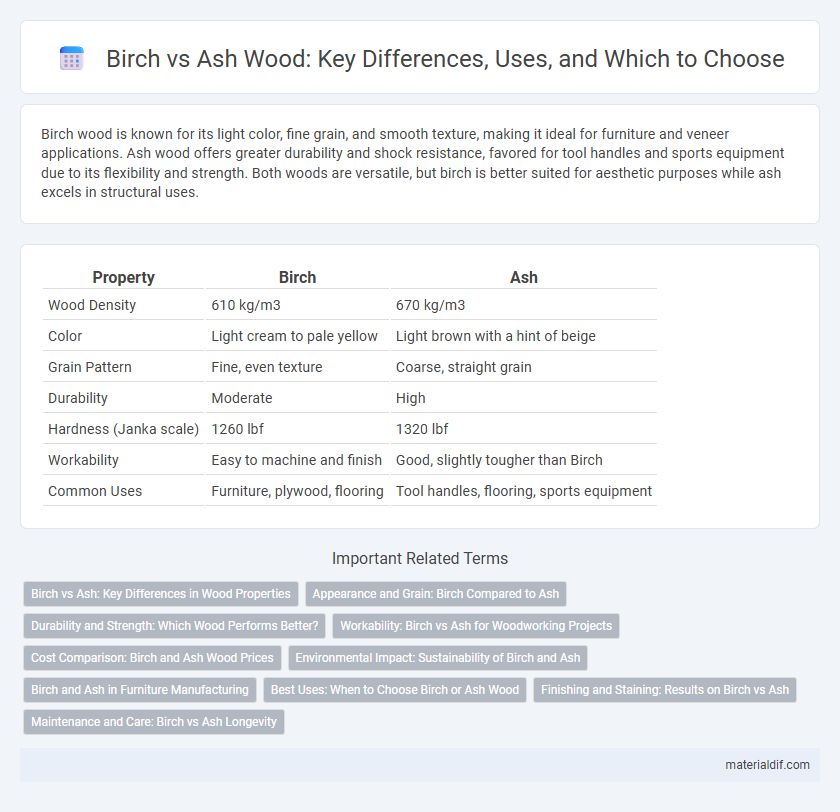Birch wood is known for its light color, fine grain, and smooth texture, making it ideal for furniture and veneer applications. Ash wood offers greater durability and shock resistance, favored for tool handles and sports equipment due to its flexibility and strength. Both woods are versatile, but birch is better suited for aesthetic purposes while ash excels in structural uses.
Table of Comparison
| Property | Birch | Ash |
|---|---|---|
| Wood Density | 610 kg/m3 | 670 kg/m3 |
| Color | Light cream to pale yellow | Light brown with a hint of beige |
| Grain Pattern | Fine, even texture | Coarse, straight grain |
| Durability | Moderate | High |
| Hardness (Janka scale) | 1260 lbf | 1320 lbf |
| Workability | Easy to machine and finish | Good, slightly tougher than Birch |
| Common Uses | Furniture, plywood, flooring | Tool handles, flooring, sports equipment |
Birch vs Ash: Key Differences in Wood Properties
Birch wood is known for its fine grain and pale color, offering excellent shock resistance and smooth finishing, making it ideal for furniture and plywood. Ash wood features a coarser grain and a slightly darker hue, prized for its superior strength, elasticity, and impact resistance, commonly used in sports equipment and tool handles. Key differences between birch and ash include density, with ash generally denser and harder, and grain texture, where birch's tighter grain provides a more uniform surface.
Appearance and Grain: Birch Compared to Ash
Birch wood features a fine, even grain with a pale cream to light brown color, often displaying subtle, wavy patterns that offer a smooth and consistent appearance. Ash wood exhibits a more pronounced, open grain with a light to medium brown hue, occasionally accented by darker streaks that highlight its natural texture. The contrast between birch's uniformity and ash's distinctive grain pattern makes each suitable for different aesthetic preferences in woodworking and furniture design.
Durability and Strength: Which Wood Performs Better?
Birch wood offers moderate durability with a Janka hardness rating around 1260, making it suitable for furniture and interior applications but less resistant to heavy wear. Ash wood excels in strength and durability, boasting a Janka hardness of approximately 1320 and exceptional shock resistance, ideal for flooring and tool handles. For projects requiring superior performance under stress, ash wood outperforms birch in both durability and overall strength.
Workability: Birch vs Ash for Woodworking Projects
Birch offers excellent workability with its fine, even texture, making it ideal for detailed woodworking projects and smooth finishes. Ash, known for its strength and flexibility, provides superior shock resistance and is easier to steam-bend, which suits furniture and tool handles. Both woods respond well to cutting, sanding, and finishing, but birch is preferable for intricate designs while ash excels in durability and resilience.
Cost Comparison: Birch and Ash Wood Prices
Birch wood typically costs between $3 to $5 per board foot, making it a more affordable option for furniture and flooring compared to ash, which ranges from $5 to $8 per board foot due to its higher demand and durability. The price difference reflects ash's superior strength and shock resistance, often preferred for sports equipment and tool handles. Birch's cost-effectiveness suits budget-friendly projects without sacrificing aesthetic quality.
Environmental Impact: Sustainability of Birch and Ash
Birch wood is highly regarded for its fast growth rate, making it a more sustainable option with a lower environmental footprint compared to ash, which grows slower and requires longer harvesting cycles. Birch's regenerative capacity supports effective forest management and carbon sequestration, while ash populations face threats from pests like the Emerald Ash Borer, impacting its sustainability. Choosing birch over ash contributes to reduced deforestation pressures and promotes ecological balance in temperate forest ecosystems.
Birch and Ash in Furniture Manufacturing
Birch wood is highly valued in furniture manufacturing for its fine grain, hardness, and smooth finish, which allows for detailed craftsmanship and a stylish appearance. Ash wood, while also durable and flexible, is preferred for its superior shock resistance and lighter color, making it ideal for both traditional and modern furniture designs. Both woods offer unique aesthetic and structural properties, but birch's consistent texture often makes it the preferred choice for polished, high-end furniture.
Best Uses: When to Choose Birch or Ash Wood
Birch wood is ideal for furniture and cabinetry due to its fine grain and smooth finish, offering durability and a lighter color that enhances interior spaces. Ash wood excels in applications requiring shock resistance and flexibility, making it a preferred choice for tool handles, sports equipment, and flooring. Choosing between birch and ash depends on whether aesthetic appeal and workability (birch) or strength and impact resistance (ash) are more critical for the project.
Finishing and Staining: Results on Birch vs Ash
Birch wood offers a smooth, even grain that absorbs stains uniformly, resulting in a consistent and vibrant finish ideal for furniture and cabinetry. Ash wood, with its pronounced grain and porous texture, produces a more textured and varied stain pattern, often highlighting natural wood features like knots. When choosing between birch and ash for finishing and staining, birch provides a cleaner, more predictable coloration, while ash delivers a rustic, character-rich appearance.
Maintenance and Care: Birch vs Ash Longevity
Birch wood requires regular sealing and moisture control to maintain its durability, as it is more susceptible to water damage and warping than ash. Ash wood offers superior longevity with less frequent maintenance, benefiting from its natural resistance to decay and wear. Proper care extends the lifespan of both woods, but ash's robust properties generally provide a longer-lasting, low-maintenance option.
Birch vs Ash Infographic

 materialdif.com
materialdif.com